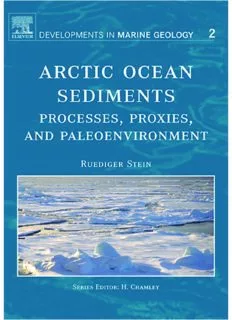
Arctic Ocean Sediments: Processes, Proxies, and Paleoenvironment PDF
Preview Arctic Ocean Sediments: Processes, Proxies, and Paleoenvironment
V OLUME TWO D M EVELOPMENTS IN ARINE G EOLOGY ARCTIC OCEAN SEDIMENTS: PROCESSES, PROXIES, AND PALEOENVIRONMENT This page intentionally left blank V OLUME TWO D M G EVELOPMENTS IN ARINE EOLOGY ARCTIC OCEAN SEDIMENTS: PROCESSES, PROXIES, AND PALEOENVIRONMENT By RUEDIGER STEIN Alfred Wegener Institute for Polar and Marine Research, Bremerhaven, Germany Amsterdam (cid:2)Boston (cid:2) Heidelberg (cid:2)London (cid:2) NewYork (cid:2)Oxford Paris (cid:2) San Diego(cid:2) San Francisco (cid:2) Singapore(cid:2) Sydney (cid:2) Tokyo Elsevier Radarweg29,POBox211,1000AEAmsterdam,TheNetherlands TheBoulevard,LangfordLane,Kidlington,OxfordOX51GB,UK Firstedition2008 Copyrightr2008ElsevierB.V.Allrightsreserved Nopartofthispublicationmaybereproduced,storedinaretrievalsystem or transmittedinanyformorbyanymeanselectronic,mechanical,photocopying, recordingorotherwisewithoutthepriorwrittenpermissionofthepublisher PermissionsmaybesoughtdirectlyfromElsevier’sScience&TechnologyRights DepartmentinOxford,UK:phone(+44)(0)1865843830;fax(+44)(0)1865853333; email:[email protected] requestonlineby visitingtheElsevierwebsiteathttp://www.elsevier.com/locate/permissions,andselecting ObtainingpermissiontouseElsevier material Notice Noresponsibilityisassumedbythepublisherforanyinjuryand/ordamagetopersons or propertyasamatterofproductsliability,negligenceorotherwise,orfromanyuse oroperationof anymethods,products,instructionsor ideascontainedinthematerial herein.Becauseofrapidadvancesinthemedicalsciences,inparticular,independent verificationofdiagnosesanddrugdosagesshouldbemade BritishLibraryCataloguinginPublicationData AcataloguerecordforthisbookisavailablefromtheBritishLibrary LibraryofCongressCataloging-in-PublicationData AcatalogrecordforthisbookisavailablefromtheLibraryofCongress ISBN:978-0-444-52018-0 ISSN:1572-5480 For informationonallElsevier publications visitourwebsiteatbooks.elsevier.com PrintedandboundinHungary 08 09 10 11 12 10 9 8 7 6 5 4 3 2 1 For Annika, Jan, Hauke, Nils, and Anna-Lena, and Kirsten-ule This page intentionally left blank C ONTENTS Preface ix Listof Abbreviations xiii Part 1: Introduction and Background 1. Introduction to the Arctic: Significance and History 3 1.1. TheArcticOceanand ItsSignificance for theEarth’s Climate System 3 1.2. Historyof Arctic OceanResearch 9 1.3. PlateTectonic Evolution andPalaeogeography 22 1.4. Glaciations inEarth’s History 30 2. Modern Physiography, Hydrology, Climate, and Sediment Input 35 2.1. Bathymetry andPhysiography 35 2.2. Oceanic Circulation PatternandWater-Mass Characteristics 40 2.3. Sea-Ice Cover:Extent, Thickness, andVariability 48 2.4. Primary Production andVerticalCarbonFluxes intheArctic Ocean 55 2.5. RiverDischarge 63 2.6. Permafrost 76 2.7. CoastalErosion 78 2.8. Aeolian Input 82 2.9. Modern Sediment Input:ASummary 84 Part 2: Processes and Proxies 3. Glacio-Marine Sedimentary Processes 87 3.1. Sea-Ice Processes: Sediment Entrainment andTransport 88 3.2. IceSheet- andIceberg-Related Processes 95 3.3. Sediment Mass-Wasting Processes 101 3.4. TurbiditeSedimentation intheCentral ArcticOcean 126 4. Proxies Used for Palaeoenvironmental Reconstructions in the Arctic Ocean 133 4.1. Lithofacies Concept 133 4.2. Grain-Size Distribution 139 4.3. Proxiesfor Sources andTransport Processesof TerrigenousSediments 146 4.4. Trace ElementsUsed forPalaeoenvironmental Reconstruction 167 vii viii Contents 4.5. Micropalaeontological Proxies andTheir(Palaeo-) Environmental andStratigraphical Significance 170 4.6. Stable Isotopes ofForaminifers 201 4.7. Organic-GeochemicalProxies for Organic-Carbon Source and Palaeoenvironment 205 Part 3: The Marine-Geological Record 5. Modern Environment and Its Record in Surface Sediments 247 5.1. Terrigenous(Non-Biogenic) Components inArctic OceanSurface Sediments: Implications for ProvenanceandModern Transport Processes 247 5.2. Organic-Carbon Content: TerrigenousSupply versusPrimary Production 273 6. Quaternary Variability of Palaeoenvironment and Its Sedimentary Record 287 6.1. TheStratigraphic Framework of ArcticOceanSediment Cores: Background, Problems,andPerspectives 287 6.2. Variability ofQuaternary IceSheets andPalaeoceanographic Characteristics: Terrestrial, Model, andEurasianContinental Margin Records 317 6.3. Circum-Arctic Glacial History, Sea-Ice Cover,and Surface-Water Characteristics: Quaternary Records fromthe CentralArctic Ocean 369 6.4. Accumulation of Particulate OrganicCarbonat theArctic Continental Margin andDeep-Sea Areas DuringLate Quaternary Times 409 7. Mesozoic to Cenozoic Palaeoenvironmental Records of High Northern Latitudes 439 7.1. MesozoicHigh-Latitude Palaeoclimate andArcticOcean Palaeoenvironment 439 7.2. CenozoicHigh-Latitude Palaeoclimate andArctic Ocean Palaeoenvironment 457 8. Open Questions and Future Geoscientific Arctic Ocean Research 497 8.1. Quaternary andNeogeneClimate Variability on Sub-Millennial to Milankovich TimeScales 498 8.2. TheMesozoic–Cenozoic History oftheArctic Ocean 500 References 507 Index 587 P REFACE Although it is generally accepted that the Arctic Ocean is a very sensitive and important region for changes in the global climate, this region is one of the last major physiographic provinces of the earth whose short- and long-term geological history is not very well known. Since the first recovery and description of deep-sea sediments during the famous 1893–1896 Fram-Expedition of Fridtjof Nansen (Nansen, 1897; Bo¨ggild, 1906), the progressingettingabetterunderstandingoftheArcticOceansystemanditsrelationshipto global change has been slow in comparison to studies in other ocean regions. This lack of knowledge is mainly caused by the major technological/logistic problems in reaching this permanently ice-covered region with normal research vessels and in retrieving long and undisturbed sediment cores. Prior to 1990, the available samples and geological data from the central Arctic Basins are derived mainly from drifting ice islands such as T-3 (e.g.,Clarketal.,1980)andCESAR(Jacksonetal.,1985),andafewshipsexpeditionssuch asYmer-80(Bostro¨m&Thiede,1984),PolarsternARK-IV/3(Thiede,1988),andPolarStar- 1988 (Phillips et al., 1992). Comprehensive summaries about the knowledge on Arctic Ocean geology based on data available prior to 1990 were published in Herman (1989), Bleil and Thiede (1990), and Grantz et al. (1990). In the following years, several international and multidisciplinary expeditions were carriedout,forexample,thePolarstern/OdenExpeditionin1991(Fu¨tterer,1992),thePolar Sea Expedition in 1993 (Grantz et al., 1998), the Louis St. Laurent/Polar Sea Expedition in 1994 (Wheeler, 1997), the Polarstern expeditions in 1998, 2001, 2004, and 2007 (Jokat, 1999; Thiede, 2002; Stein, 2005; Schauer, 2008), and the Akademik Federov Expedition in 2000 (Kabanukov et al., 2004), the Oden expeditions in 2001 and 2007 (Gro¨nlund, 2001; Jakobsson,Polyak,&Darby,2007b),andtheHealy/OdenExpeditionin2005(Darbyetal., 2005). Furthermore, major multidisciplinary circum-Arctic research programmes and initiatives were developed, for example, SEARCH (The Study of Environmental Change; Morison et al., 2001), SBI (Arctic Shelf-Basin Interactions; Grebmeier & Harvey, 2005), APARD(ArcticPaleo-RiverDischarge;Stein,1998),andACD(ArcticCoastalDynamics; Rachold, Are, Atkinson, Cherkashov, & Solomon, 2004b). Prior to 2004, the geological sampling in the Arctic Ocean was restricted to obtaining near-surface sediments, that is, only the upper 15m could be sampled by means of gravity and piston coring. Thus, all studies were restricted to the Late Pliocene-Quaternary time interval, with one exception. In four short sediment cores from Alpha Ridge where older strataarecropping-out,upperCretaceousandlowerTertiarysedimentscouldbesampledby gravity coring from an ice flow (see Chapter 7). That means, the old pre-Pliocene palaeoenvironmental history of the central Arctic Ocean was almost unknown. This situationchangedwiththefirstscientific drillingonLomonosovRidge,whichwascarried out in August/September 2004 within the framework of the Integrated Ocean Drilling Program(IODP).DuringthisIODP–ACEX(ArcticCoringExpedition)expedition,which isabreak-throughfor palaeoenvironmentalresearch,amorethan 400mthicksedimentary ix
Description: